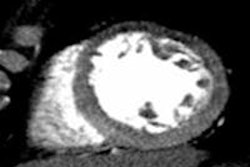A negative coronary CT angiography (CTA) has a high predictive value for ruling out acute coronary syndrome and can decrease the hospital stay of patients who come to emergency rooms complaining of severe chest pain, according to a new study conducted in Saudi Arabia.
The American College of Cardiology and the American Heart Association recommend hospitalization for those with a low to intermediate risk of acute coronary syndrome who have an initial negative electrocardiogram (ECG) and enzyme test results, noted the study authors.
However, using coronary CTA to detect significant coronary stenosis could help decrease the length of hospital stay for these low-risk chest-pain patients, without reducing appropriate care (Egyptian Journal of Radiology and Nuclear Medicine, December 2013, Vol. 44:4, pp. 755-763).
Dr. Tamir Hassan, from the department of radiodiagnosis at Zagazig University in Egypt, told AuntMinnie.com that he decided to conduct the study while working in a hospital in Saudi Arabia that saw a heavy flow of low-risk patients with chest pain.
According to the current standard of care, these patients remained in the hospital for approximately 20 hours, despite tests such as ECG and cardiac enzymes being normal. These patients would then go on to receive stress echo or scintigraphy, he said.
"We thought of breaking this cycle by introducing cardiac CTA to shorten the length of stay," Hassan said. "We reached about five hours instead of 20 hours, thus saving about 15 hours of unnecessary hospital admissions."
CTA for triage
Coronary CTA has been suggested as a strategy to rule out significant coronary artery disease among patients at low or intermediate risk, in particular because of its ability to visualize coronary anatomy, the authors wrote. Because acute coronary syndrome is rare in the absence of coronary atherosclerotic plaque, many researchers have suggested that coronary CTA could improve the triage of patients with acute chest pain, as well as reduce healthcare costs.
Hassan and co-author Dr. Mohamed Abdalaal screened patients in the emergency room (ER) of a Saudi hospital between July 2011 and April 2013. They included 54 patients who were suffering from acute chest pain and had a low Thrombolysis in Myocardial Infarction (TIMI) risk score of 0 to 2. These patients were awaiting hospital admission to rule out acute coronary syndrome, despite the absence of diagnostic ECG changes and their having normal cardiac enzymes.
Coronary CTA was initiated after the ER physician decided to admit the patient to the hospital. At admission, as part of standard clinical care, the patients underwent 12-lead ECG, a cardiac troponin I test, and chest radiography. They also had blood laboratory work and received drugs tailored to their symptoms. After the coronary CTA exam, they were transferred to the emergency department observation unit, and standard clinical care testing continued.
The ER physician involved with the patients' care was blinded to the coronary CTA results. A two-person expert panel established the presence or absence of acute coronary syndrome based on American Heart Association guidelines. The coronary CTA images were evaluated for the presence of significant coronary artery stenosis and were used to make a triage decision.
Significant stenosis at coronary CTA consisted of more than 50% luminal narrowing. Four patients had at least one significant coronary stenosis and two patients had poor coronary CTA image quality. Significant coronary stenosis was excluded in 48 of the 54 patients.
In the four cases detected by coronary CTA, the severity of stenosis was 52% to 73%; three were true positives and one was a false positive as indicated by coronary catheter angiography.
Shorter length of stay
The average length of hospital stay for standard clinical care alone was 20.4 ± 6.3 hours, according to the authors. In comparison, the average projected length of stay for a coronary CTA-based strategy with observation was 12.3 ± 5 hours, and length of stay for a coronary CTA-based strategy without observation was 5 ± 1 hours.
"In the projected length of stay for coronary CTA-based strategy without observation we saved 14.6 ± 5.3 hours in each case, thus saving 71.6% of unnecessary hospital admission hours," they wrote.
A one-month follow-up of 50 patients showed no repeat visits to the emergency room or repeated hospitalizations for acute coronary syndrome.
Hassan explained that one unique aspect of their study was the use of adaptive statistical iterative reconstruction (ASIR, GE Healthcare) to lower radiation dose. ASIR incorporates statistical modeling to reduce image noise, potentially preserving image quality with a lower tube current, thereby lowering radiation dose, the authors wrote.
This is where the study differs from previous research (New England Journal of Medicine, July 26, 2012, Vol. 367:4, pp. 299-308) that also found that incorporating coronary CTA for triage improved clinical decision-making, Hassan said. In the NEJM study, there was also an increase in downstream testing and radiation exposure.
Hassan and Abdalaal achieved a mean radiation dose of 4.9 mSv ± 1.1 mSv in the current study with the application of ASIR. The goal is to offer coronary CTA with the lowest radiation dose possible to overcome that disadvantage of the 2012 trial.
"I encourage every radiologist to offer cardiac CT in particular and CT in general with the lowest radiation using the new techniques of iterative reconstruction," Hassan said. "I think patients will be happy to have the test with the lowest risk possible."



















